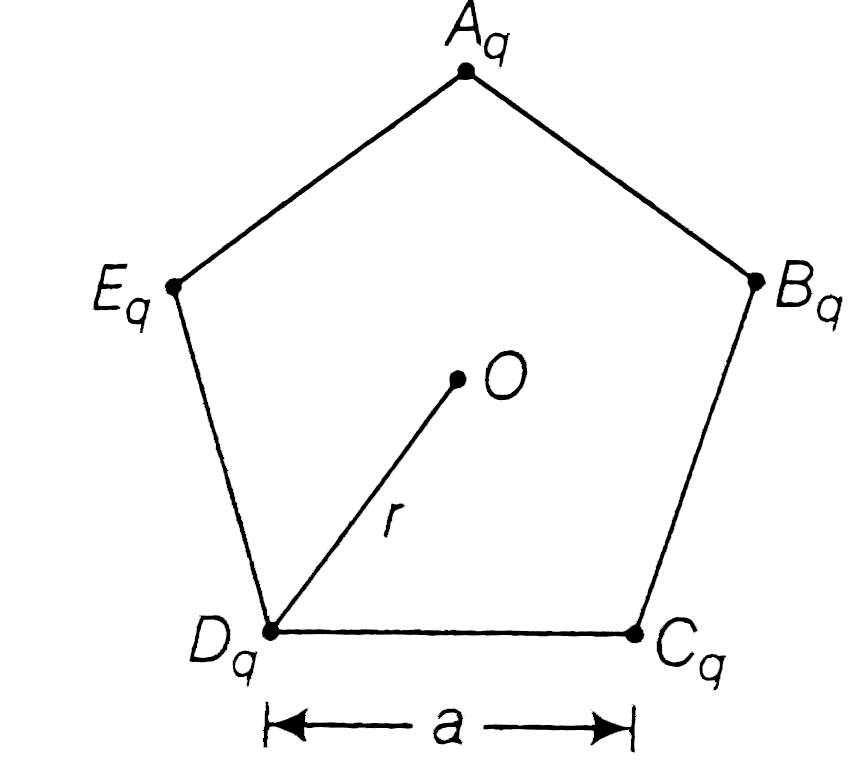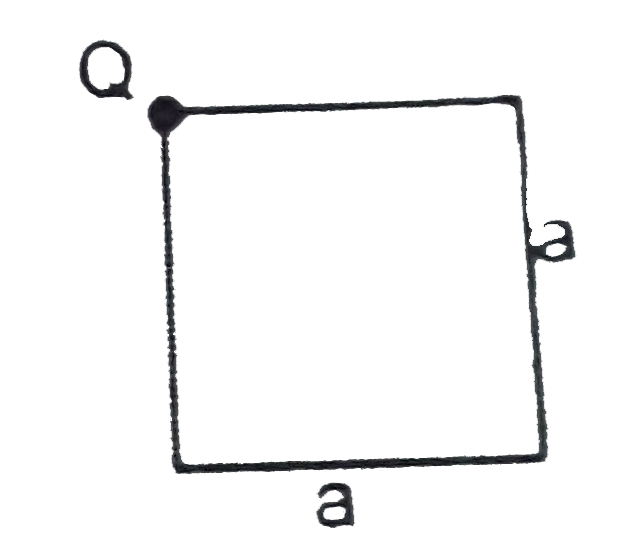Three charges, each equal to q, are placed at the three. corners of a square of side a . Find the electric field at. the fourth corner.
To find the electric field at the fourth corner of a square where three charges are placed at three corners, we can follow these steps:
Step 1: Understand the Configuration
We have three charges, each equal to q, placed at three corners of a square with side length a. We need to find the electric field at the fourth corner (let's call it point D).
Step 2: Determine the Electric Field Due to Each Charge
1. Electric Field due to Charge at Corner A (E1):
- The charge at corner A creates an electric field at point D directed away from A (since the charge is positive).
- The distance from A to D is a.
- The magnitude of the electric field E1 is given by:
E1=kqa2
- The direction of E1 is along the line AD.
2. Electric Field due to Charge at Corner B (E2):
- The charge at corner B also creates an electric field at point D directed away from B.
- The distance from B to D is a.
- The magnitude of the electric field E2 is:
E2=kqa2
- The direction of E2 is along the line BD.
3. Electric Field due to Charge at Corner C (E3):
- The charge at corner C creates an electric field at point D directed away from C.
- The distance from C to D is √2a (the diagonal of the square).
- The magnitude of the electric field E3 is:
E3=kq(√2a)2=kq2a2
- The direction of E3 is directed towards point D from point C.
Step 3: Resolve the Electric Fields into Components
- The electric fields E1 and E2 are along the axes of the square.
- The electric field E3 can be resolved into its x and y components since it is at a 45∘ angle to the axes:
E3x=E3⋅cos(45∘)=kq2a2⋅1√2=kq2√2a2
E3y=E3⋅sin(45∘)=kq2a2⋅1√2=kq2√2a2
Step 4: Calculate the Resultant Electric Field
- The total electric field in the x-direction Ex is:
Ex=E1+E3x=kqa2+kq2√2a2=kqa2(1+12√2)
- The total electric field in the y-direction Ey is:
Ey=E2+E3y=kqa2+kq2√2a2=kqa2(1+12√2)
Step 5: Calculate the Magnitude of the Resultant Electric Field
- The magnitude of the resultant electric field Enet can be calculated using the Pythagorean theorem:
Enet=√E2x+E2y=
⎷2(kqa2(1+12√2))2
Enet=kqa2(1+12√2)√2
Final Result
Thus, the electric field at the fourth corner is:
Enet=kq√2a2(1+12√2)
We have three charges, each equal to q, placed at three corners of a square with side length a. We need to find the electric field at the fourth corner (let's call it point D).
1. Electric Field due to Charge at Corner A (E1):
- The charge at corner A creates an electric field at point D directed away from A (since the charge is positive).
- The distance from A to D is a.
- The magnitude of the electric field E1 is given by:
E1=kqa2
- The direction of E1 is along the line AD.
- The charge at corner B also creates an electric field at point D directed away from B.
- The distance from B to D is a.
- The magnitude of the electric field E2 is:
E2=kqa2
- The direction of E2 is along the line BD.
- The charge at corner C creates an electric field at point D directed away from C.
- The distance from C to D is √2a (the diagonal of the square).
- The magnitude of the electric field E3 is:
E3=kq(√2a)2=kq2a2
- The direction of E3 is directed towards point D from point C.
- The electric fields E1 and E2 are along the axes of the square.
- The electric field E3 can be resolved into its x and y components since it is at a 45∘ angle to the axes:
E3x=E3⋅cos(45∘)=kq2a2⋅1√2=kq2√2a2
E3y=E3⋅sin(45∘)=kq2a2⋅1√2=kq2√2a2
- The total electric field in the x-direction Ex is:
Ex=E1+E3x=kqa2+kq2√2a2=kqa2(1+12√2)
Ey=E2+E3y=kqa2+kq2√2a2=kqa2(1+12√2)
- The magnitude of the resultant electric field Enet can be calculated using the Pythagorean theorem:
Enet=√E2x+E2y=
⎷2(kqa2(1+12√2))2
Enet=kqa2(1+12√2)√2
Thus, the electric field at the fourth corner is:
Enet=kq√2a2(1+12√2)
Topper's Solved these Questions
- ELECTRIC FIELD AND POTENTIALBOOK - HC VERMACHAPTER - ELECTRIC FIELD AND POTENTIALEXERCISE - Short Answer
14 Videos
- ELECTRIC FIELD AND POTENTIALBOOK - HC VERMACHAPTER - ELECTRIC FIELD AND POTENTIALEXERCISE - Objective 1
9 Videos
- ELECTRIC FIELD AND POTENTIALBOOK - HC VERMACHAPTER - ELECTRIC FIELD AND POTENTIALEXERCISE - Exercises
75 Videos
- ELECTRIC CURRENT THROUGH GASESBOOK - HC VERMACHAPTER - ELECTRIC CURRENT THROUGH GASESEXERCISE - Exercises
23 Videos
- ELECTROMAGNETIC INDUCTIONBOOK - HC VERMACHAPTER - ELECTROMAGNETIC INDUCTIONEXERCISE - EXERCISE
9 Videos
Similar Questions
Knowledge Check
Three masses, each equal to M, are placed at the three corners of a square of side a. the force of attraction on unit mass at the fourth corner will be
AGM3a2BGMa2√3C3GMa2DGMa2[12+√2]Three charges ,each of +4μC ,are placed at the corners A,B,C of a square ABCD of side 1m.The electric field at the centre O of a square ABCD of side 1m.The electric field at the centre O of the square is
A7.2×104N/C towards DB7.2×104N/C towards BC3.6×104N/C towards AD7.2×104N/C towards CEqual charges q are placed at the three corners B, C, D of a square ABCD of side a. The potential at A is
A14πε0qaB3q4πε0Cq4πε0a[2+1√2]Dq4πε0a[1+√2]
Five charges , q each are placed at the corners of a regular pentagon of side.

(a) (i) What will be the electric field at 0, the centre of the pentagon?
(ii) What will be the electric field at 0 if the charge from one of the corners (say A) is removed?
(iii). What will be the electric field at 0 if the pentagon is replaced by n-sided regular polygon with charge q at each of its corner?
View SolutionA point charge Q is placed at the corner of a square of side a, then find the flux through the square.

View SolutionThree identical point charges Q are placed at the three corners of an equilateral triangle of side length a. Find the electric potential at points O and M due to the three charges.

View SolutionFive charges, q each are placed at the corners of a regular pentagon of side a. (Refer the adjoining figure)
(a) (i) What will be the electric field at O, if the centre of the pentagon?
(ii) What will be the electric field at O if the charge from one of the corners (say A) is removed?
(iii) What will be the electric field at O if the charge q at A is replaced by -q?
(b) How would your answer to (a) be affected if pentagon is replaced by n-sided regular polygon with charge q at each of its corners?

View SolutionFive point charge (+q each) are placed at the five vertices of a regular hexagon of side 2a.what is the magnitude of the net electric field at the centre of the hexazon?
View Solution

